This is a Paxette IIM, a 35mm rangefinder camera made by Carl Braun Nürnberg, in Nuremberg, West Germany between the years 1953 and 1955. The Paxette IIM was one in a large family of Paxette cameras, dating back to the original Paxette from 1950. Differentiating between the different Paxette models can be confusing as many of the early models do not identify their model number anywhere on the camera, simply being referred to as a “Paxette”. This model, with the IIM identifier, means it has an interchangeable lens mount and an uncoupled rangefinder. The lens mount is a 39mm screw mount, but due to having a leaf, instead of focal plane shutter, the flange distance is not the same as lenses using the Leica Thread Mount, so therefore the lenses are incompatible. Although quite a few lenses were made for the Paxette, they must be Paxette specific lenses to work.
Film Type: 135 (35mm)
Lens: 45mm f/2.8 Staeble-Kata coated 3-elements in 2-groups
Lens Mount: 39mm Paxette Screw
Focus: 2.5 feet to Infinity
Viewfinder: Coincident Image Uncoupled Rangefinder
Shutter: Prontor SVS Leaf
Speeds: B, 1 – 1/300 seconds
Exposure Meter: None
Battery: None
Flash Mount: Cold shoe with M and X Flash Sync
Other Features: Self-Timer
Weight: 486 grams, 432 grams (body only)
Manual: https://www.cameramanuals.org/pdf_files/paxette_ii_m.pdf
How these ratings work |
The Braun Paxette IIM is a capable entry in the Paxette series with interchangeable lenses and a coincident image rangefinder. The camera is very compact, offering good ergonomics, and excellent portability. Despite having a lens that likely won’t excite too many collectors, the camera’s 3-element Staeble-Kata lens delivers very good results. The camera isn’t perfect with a squinty viewfinder and awkward film loading, but it’s small size more than makes up for it. This is a fine camera that is worthy of your consideration. | ||||||
| Images | Handling | Features | Viewfinder | Feel & Beauty | History | Age | |
| 2 | 2 | 1 | 0 | 1 | 1 | 30% | |
| Bonus | none | ||||||
| Final Score | 9.1 | ||||||
History
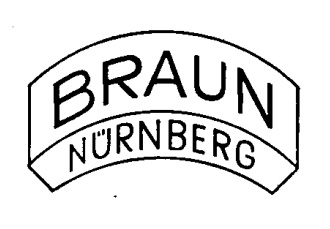 Braun was a maker of mostly compact 35mm scale focus and rangefinder cameras in the 1950s and 60s. Although also from Germany, a separate company called Braun founded in 1921 in Frankfurt by a German inventor named Max Braun as a maker of radios, electric shavers, and small appliances is not related. The Braun company who made cameras, was based out of Nuremberg (Nürnberg), Germany in the German state of Bavaria. There is conflicting information about the origins of this company online, some saying the company was founded in 1906, and others in 1915 as Karl Braun KG. I am inclined to believe the 1915 date as this is the date stated on the current day Braun’s official website.
Braun was a maker of mostly compact 35mm scale focus and rangefinder cameras in the 1950s and 60s. Although also from Germany, a separate company called Braun founded in 1921 in Frankfurt by a German inventor named Max Braun as a maker of radios, electric shavers, and small appliances is not related. The Braun company who made cameras, was based out of Nuremberg (Nürnberg), Germany in the German state of Bavaria. There is conflicting information about the origins of this company online, some saying the company was founded in 1906, and others in 1915 as Karl Braun KG. I am inclined to believe the 1915 date as this is the date stated on the current day Braun’s official website.
Regardless of which date is correct, most sites state that Braun’s earliest products were not camera related, but rather were optical products like binoculars, scopes, and other various products for the radio industry. There is surprisingly little information about the company during this period or any evidence of products showing up for sale with a Braun name, so its also possible that they were a “white label” supplier for other companies. This is just speculation though.
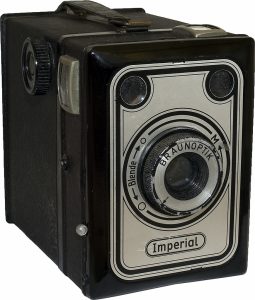
In 1948, the company would change it’s name to Carl Braun Kamera-Werke Nürnberg and would release it’s first box cameras under the name “Imperial Box”. The first models shot 6×9 images, but a later variant shot 6×6.
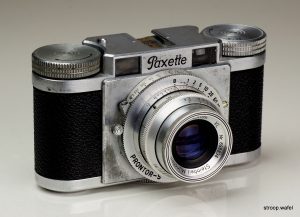
In 1950, Braun ventured into 35mm cameras with the first Paxette, a compact solid bodied 35mm scale focus camera. The front of the original Paxette had twin viewfinders which make them look like they have a rangefinder, but in fact, the window on the photographer’s right side is an extinction meter for calculating exposure.
Throughout the 1950s, the Paxette would go through a rapid and confusing series of upgrades and revisions. Braun released a huge number of Paxette variants with seemingly identical features, but with lens and shutter combinations supporting a huge number of lens makers from little known companies like Roeschlein-Kreuznach to top tier companies like Zeiss.
Later Paxettes would have several different interchangeable lens mounts, the first was a 39mm screw mount that supported a number of accessory lenses designed for the Paxette. Although physically identical to the M39 “Leica Thread Mount” used by focal plane rangefinders, due to the need for the lens to sit farther away from the film plane because of the leaf shutter, Paxette screw mount lenses are not compatible with Leica screw mount lenses. The Paxette’s 39mm screw mount has a flange focal distance of 45.7mm away from the film plane, compared to 28.8mm on a Leica. This is almost identical to that of the M42 SLR screw mount, so any attempt to mount a Leica lens on a Paxette (or vice versa) will result in badly out of focus images. Later Paxettes would feature rangefinders, first in uncoupled designs, and later coupled.


If you are trying to identify a Paxette and are confused by the many different models, most Paxettes equipped with uncoupled rangefinders had the number “II” in the name. Later models with coupled rangefinders were called “Super Paxettes”. If the camera has an interchangeable lens mount, it would have an “M” in the name. The camera being reviewed in this article lacks the “Super” name because the rangefinder is uncoupled, but has a rangefinder and interchangeable lens mount, so it is called a Paxette IIM.
As best as I can tell, the Braun Paxettes were not exported to the United States. All advertising I’ve found for these cameras is in German or found with prices in non-US currencies. The follow up to the Paxette IIM was called the Super Paxette I and II in Germany, but was imported to the US simply as the Braun 35.
The ad to the left for the Braun 35 mentions American photo distributors such as Burke & James, and Ponder & Best who eventually became Vivitar, suggesting these were the first places where Braun cameras were sold. The Super Paxette is a more advanced model than the Paxette IIM sold here, and carried a $79.50 retail price, which when adjusted for inflation compares to about $880 today.
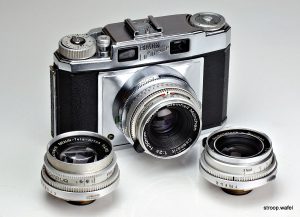
After the screw mount Paxette, Braun would release cameras with no less than three different bayonet mounts in a short period of time from the late 1950s to the early 1960s. A model called the Braun Paxette Super III Automatic would share a similar, but not identical, bayonet mount with the King Regula Super, and Photavit 36. The Paxette IA Electromatic used something called the Paxette bayonet which was not used on any other camera made by Braun or anyone else. Finally, Braun’s last rangefinder model, the Braun Super Colorette II, didn’t use the Paxette name, but used the Deckel bayonet, which was shared by the Kodak Retina and other cameras made by Iloca, Wittnauer, and Voigtländer. For more information, including several excellent photos of the various mounts, check out Cees-Jan de Hoog’s excellent Paxette page.
Although Braun would make a few other types of cameras besides the Paxette series, these were the brand’s biggest successes and the ones they are most well known for. Despite being made by a relatively small newcomer to the post war German camera industry, Paxettes were well built and very affordable, often having features typically reserved for more expensive cameras.
The company would continue producing cheaper and simpler cameras until the late 1960s until the point where it was no longer profitable to do so. It would continue producing slide projectors and other products in the photo industry for the next couple of decades before going bankrupt in the early 2000s.
Today, the Braun Paxette series appeal to many collectors due to their good build quality, compact size, and good selection of lenses. The later models are certainly more capable, but for someone wanting an attractive and small model with interchangeable lenses, you could do a lot worse. The early Paxettes are very small and easily fit into a small handbag or a coat pocket, making them excellent carry around cameras. I don’t know that there’s many Braun specific collectors out there, but I would suspect a large number of general purpose collectors, likely have at least one or two in their collection, and you should too!
My Thoughts
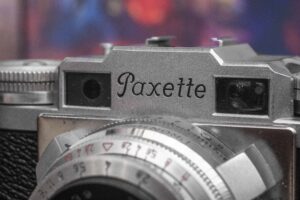
Having already reviewed a different Braun Paxette model back in August 2018, I wasn’t super eager to take a look at another, but as it often does, fate sometimes has other plans. For a period of time in early 2022, I kept coming across Paxettes. Most of them were the very early models that looked to be in pretty poor shape and likely not in working condition. I took note of the uptick of Paxettes and moved on. Later that summer, in a lot of cameras I was interested in, I saw what looked to be a really nice looking early-but-not-too-early model and picked it up.
As it turns out, fate was trying to tell me something with all those Paxettes as when the new one arrived, I was immediately taken by it’s size, feel, and most importantly, it’s condition. The first thing I did was try to identify which exact model this was as the entire lineage of Paxette models is very large and very confusing.
Thankfully, as he often does, Cees-Jan de Hoog from CJ’s Classic Cameras came through with his excellent page on the Paxette series, showing the difference between all the models. I identified mine as a Paxette IIM from about 1953. The “II” in the model name indicates that this has a rangefinder, and the “M” means it has an interchangeable lens mount.
As I handled the camera, the thing that stuck out to me the most was it’s compact size. This is a very small and dense feeling camera. The body has similar curved edges to a screw mount Leica, and when compared side by side with one, has the exact same thickness. The shutter and lens mount extend farther out than the Leica body, but with the Staeble-Kata lens mounted, it was exactly the same thickness front to back as a Leica with collapsible 5cm f/3.5 Elmar. The hump on the Paxette top plate where the accessory shoe is located, does stick up a tad higher than the top plate on a Leica, but the “shoulders” of the camera and tops of the knobs are about the same. Width is where there is a big difference as the Paxette is considerably shorter. With both cameras placed bottom to bottom, the Paxette body ends at about where the left rangefinder window is on the Leica.
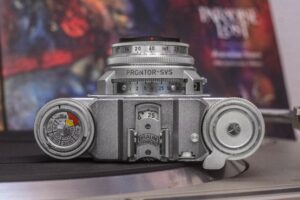
For anyone who likes symmetry, the Paxette is the camera for you as the top plate is very well balanced. The hump between the two knobs is perfectly centered, as is the accessory shoe and exposure counter in front of it. The exposure counter must be manually reset after each new roll is installed and is subtractive, showing how many exposures are left on a roll of film.
To the left of the hump is the film rewind knob which has a film reminder disc on top of it. An unusual oddity of the rewind knob, is that in it’s normal position, it is uncoupled from the film cassette. This means that as film transports through the camera, this knob does not rotate. As someone who is sensitive to film transport problems, I always like to keep an eye on the rewind knob when shooting old film cameras to make sure the film is moving correctly. You can overcome this by pulling up on the knob to it’s rewind position and leaving it there. It won’t negatively affect the film transport, but you’ll be able to see the knob turn as you advance the film. If however, you are so confident that film is transporting through your camera, then leave it in the down position and don’t worry about it.
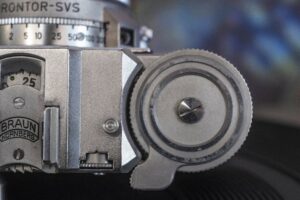
On the right is the film advance lever which has a small handle sticking out of it’s side. The film advance requires two strokes, but I wouldn’t describe it as a true “double stroke” as the second stroke doesn’t go as far as the first. It’s more like a ‘one and two-thirds stroke camera’. Next to it is the control wheel for the uncoupled rangefinder which I will explain later, and finally a rewind release button that must be pressed and held while rewinding film to disable the film transport.
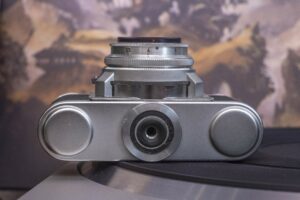
Flip the camera over and in the center is a metal 1/4″ tripod socket with a large circular lock around it which is used to remove the camera back and bottom for film loading. The lock follows the standard “righty tighty lefty loosey” rule and unscrews easily. Although I have no problem with circular locks like these as many other cameras have them too, the design of the one on the Paxette is my least favorite thing about the camera as the lock ring sticks out more than the two round feet that are on either side of the bottom. This effectively renders them useless as they never touch the surface the camera is sitting on. The entire weight of the camera balances on the circular lock in the center which doesn’t give the body much stability. It does sit flat on a table, but the slightest bump causes the camera to wiggle.
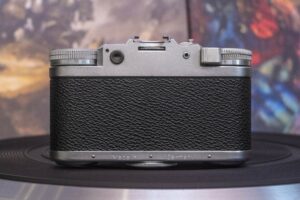
Around back is a continuation of the black pebbled body covering from the front of the camera. I am unsure of what the material is, but on this example it has held up well and has no scratches, is not peeling, nor is it sticky. Above the back is the circular eyepiece for the viewfinder, a serrated wheel below the accessory shoe for manually resetting the exposure counter, a rangefinder adjustment screw hole, and the back of the film advance lever. Below the door is a ‘Made in Germany’ engraving.
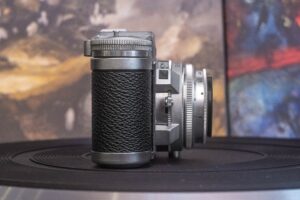
On the sides, the Paxette continues the symmetrical theme as both sides are equally rounded and have little of interest. There are no flash sync ports or strap lugs on the body, meaning that the only way to use a neck strap would be with the camera’s original case, or one of those that use the tripod mount. On each side of the shutter are sliders for M and X flash synchronization, and a V setting for the self-timer, and on the other side, the shutter release lever.
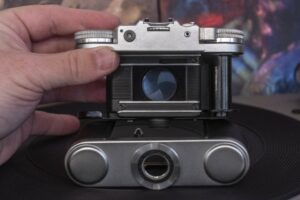
Perhaps the most distinct feature of the Paxette series, is the film compartment. Although having the appearance of a bottom loader, opening the circular lock on the bottom plate and pulling the back off removes the entire back, bottom, and part of the front of the camera revealing an inner chassis consisting of the film compartment, film gate, and an inner frame. An advantage to this design compared to a camera in which the seams are on the sides is that there is less chance of light leaks from the edges of the back. A film pressure plate is hinged to the body above above the film gate and must be swung up before loading or unloading film. In addition, a hinged arm beneath the supply spool swings out of the way to simplify loading.
Film transports from left to right onto a fixed and single slotted plastic take up spool. With the pressure plate swung out of the way, load film by attaching the leader, stretch it across the gate and hold the cassette onto the rewind fork while sliding the back onto the camera and you’re done. The pressure plate is black painted metal and has a pattern of divots on it to reduce friction as film passes over it. Unpainted film rails above and below the film gate also aide in smooth film transport. Finally, a large metal spring on the back of the door maintains tension on the pressure plate with film in the camera.

Looking down upon the top of the Prontor-SVS shutter, we easily see every available shutter speed plus Bulb, which is chosen by rotating a ring around the shutter. A knurled ring in front of the Prontor logo is a grip on the lens for removing it from the camera. In front of that is a focus scale with distances marked from 2.5 feet to infinity. To the right of the 1/300 shutter speed is a rectangular opening which inside has a cable release socket. Up front, the Staeble-Kata 45mm f/2.8 lens has a black ring for selecting aperture f/stops from 2.8 to 16. This ring turns smoothly, without click stops.

The Paxette IIM uses a 39mm screw mount, which is physically the same as the 39mm Leica Thread Mount, but due to the thickness of the leaf shutter, the lens flange is located 45.7mm away from the film plane, compared to 28.8mm on a Leica Thread Mount camera, meaning LTM lenses cannot be used on this camera. They’ll physically mount, and in theory, could be used for extreme closeups, but without an accurate way to measure focus distance, would result in completely out of focus images.
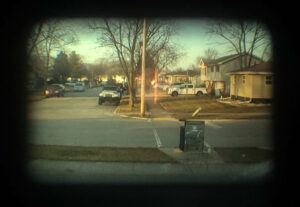
Looking through the small eyepiece into the viewfinder, the image is quite small. I was unable to see all four edges of the frame while wearing prescription glasses. The main viewfinder has a bluish green tint it with a clear circular rangefinder patch. Like most coincident image rangefinder cameras, proper focus is obtained when the two images visible in the rangefinder patch and the main viewfinder are aligned.
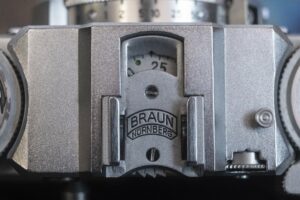
Unlike most rangefinders however, the one on the Paxette IIM is uncoupled, which means you must rotate a separate wheel located on the top plate of the camera between the shoe and advance lever. This lever is what moves the rangefinder patch, and once the two images are lined up, you must look at the distance indicated on the rangefinder wheel, and match that with the focus distance of the lens.
Adding this additional step does slow you down and could likely be a deal breaker for someone not used to an uncoupled rangefinder, however with the good depth of field afforded by the slightly wide 45mm lens means that precise focus is only needed when shooting at close distances, or with the lens wide open. For most general purpose photography focused from 8 feet to infinity, depth of field is wide enough so that guessing focus is all that’s required. In use, the rangefinder doesn’t need to be used for every shot.
The Paxette IIM has a lot going for it. On paper, it has everything you could ever want in a mid century interchangeable lens 35mm rangefinder camera. The big difference between this and comparable other German cameras is it’s size. The Paxette is quite a bit smaller than cameras like the Leica, and usually, when something is shrunk down, compromises have to be made. But which ones, and will they affect the shooting performance? Keep reading…
My Results
For the first roll of film in the Braun Paxette IIM, I chose my most reliable film, Kodak TMax 100, of which I have several 100′ bulk rolls of. Kodak TMax 100 is not only ideal as it is a reliable and well balanced film with good sharpness, fine grain, and good latitude, but as an ASA 100 speed film, it falls into that sweet spot of vintage cameras where shutter speeds like 1/60 and 1/125 are typically the most reliable. Since I don’t have the luxury to be able to give a full CLA to every camera before testing it, I am often using cameras with shutters which may be wildly inaccurate, or in some cases completely non-functional at the shutter’s fastest and slowest speeds. Just because I cannot fire a shutter at 1 or 1/1000 second, doesn’t mean I can’t still use it at 1/125 using TMax 100 and Sunny 16.
Aside from a couple light leaks that entered the film compartment near the end of the roll due to user error, the images I got from my test roll of the Paxette IIM were quite good. I went into shooting this camera with high hopes, but knowing the reputation of B-list German lenses like the Staeble-Kata, I tried not to get too excited.
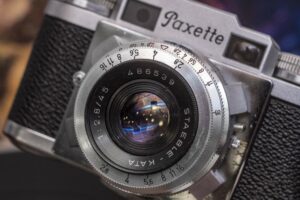
Thankfully, the 45mm f/2.8 triplet performed remarkably well, at least as good as any other Zeiss or Schneider triplets I’ve tested. Sharpness in the center was excellent with minimal softening near the edges. Only the slightest amount of vignetting is visible in images where the sky is present, but for most other shots, isn’t visible. Out of focus details on lenses like these can often be mushy, or with unpleasant bokeh, but that wasn’t the case here. While I made no attempt at getting “intentional bokeh” I didn’t notice any unpleasant out of focus details like some lesser lenses can often have. I came away very impressed with the camera and this lens, wondering if had there been an upgrade to a higher spec lens would have even been worth it.
Using the Paxette IIM is a mixed bag. On the upside, the build quality is excellent. The Paxette feels like a more luxurious camera than it’s original price tag likely suggested, All of the camera’s primary controls are in logical locations. The shutter mounted shutter release is comfortably located and in easy reach of your right index finger. Changing shutter speeds, aperture f/stops and focus are all done on the lens exactly as you would expect to on a leaf shutter camera. The rewind knob is very large, and makes rewinding the film at the end of the roll a pleasure, especially considering the small size of the camera. The film advance is on an equally large knob, but has a very stubby lever, requires multiple strokes to advance one full frame, which does slow you down, but considering cameras like the Leica M3 originally had double strokes too, at least the Paxette was in good company.
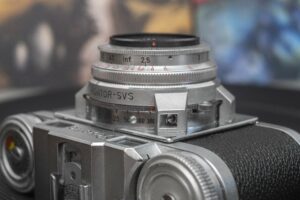
The things that are not so nice are the tiny viewfinder and uncoupled rangefinder. Although tiny finders and uncoupled rangefinders were common in the era the camera was built, using the viewfinder with prescription glasses is difficult as you cannot see the whole image. Further, even if you want to use the rangefinder, the tiny rangefinder patch in an already tiny viewfinder makes using it very difficult in all but the brightest conditions. Add in a little bit of age-related haze, and the whole thing is downright useless. While the one in this example was still easy to see, I rarely found myself wanting to use it, instead using it like a scale focus camera. Thankfully, the 45mm kens gives good enough depth of field for most shooting situations.
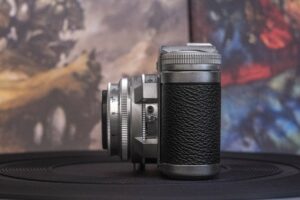
Without a doubt though, my favorite part of the Paxette IIM is it’s compact size. This camera is misleadingly small. At only 506 grams and over a centimeter shorter than a screw mount Leica, it has got to be one of the smallest interchangeable lens rangefinder cameras ever made. With it’s light weight and small size, the curved edges make the camera very easy to take in and out of a medium sized pocket or small handbag. It’s unobtrusive size and weight, combined with how easy it is to make great images, make this an excellent every day camera, or one for hiking trips or family visits to the zoo.
The Paxette IIM certainly isn’t perfect, and there are definitely many cameras that can do it’s job just as well, but you could also do a lot worse, so for that, this is a camera that I definitely recommend. If you’re on the fence about getting one, do it!
Related Posts You Might Enjoy
External Links
https://camerapedia.fandom.com/wiki/Braun_Paxette_series
https://oldcamera.blog/2013/03/02/braun-paxette-iim/
http://www.cjs-classic-cameras.co.uk/paxette/paxette.html#iim
https://retinarescue.com/paxettehistory.html
https://www.photo.net/forums/topic/338591-paxette-iim-staeble-kata-45mm-spot-the-mistake/

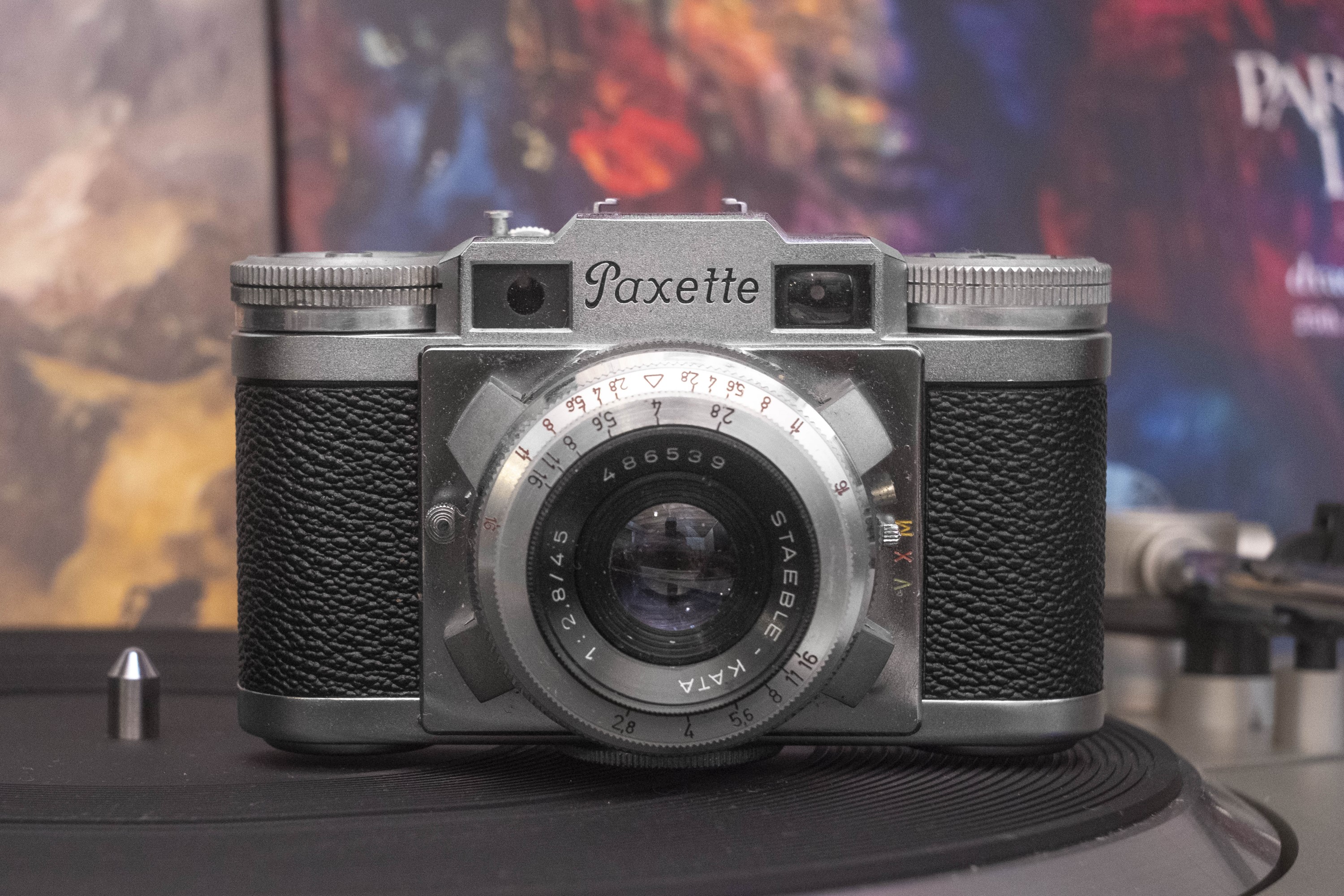
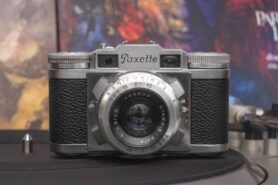
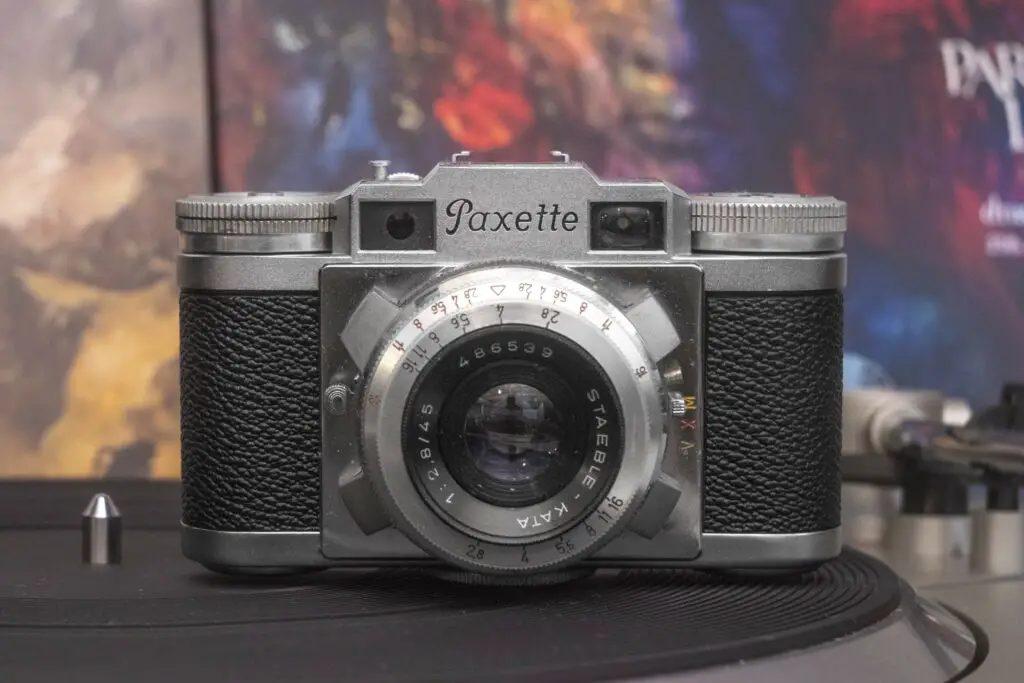
















I have the Super Paxette II with coupled rangefinder and concur totally with your review. It’s a great little “chuck in bag” camera for times with you want something small/quiet. Chunky and hardy. The Schneider Xenar is technically a bit more sharp/contrasty but there’s likely not a big diff shot on film. Viewfinder is hard to see whole image even without glasses. That’s the only drawback for me.
I have a Paxette II M with the distance scale in feet. So it was either for sale in the US or the UK.